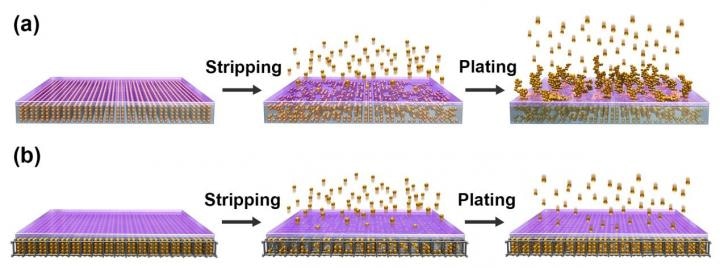Jan 10 2019
High-energy-density energy storage systems are highly sought after. From the time Sony Corporation launched the existing commercial lithium (Li) ion batteries (LIBs) in 1991, they have achieved remarkable progress and continue to dominate a huge part of the electric vehicle and portable electronics markets.
 A housed Li anode with upper solid electrolyte layer and bottom carbon fiber matrix is constructed for lithium metal batteries with long cycling life. (Image credit: Science China Press)
A housed Li anode with upper solid electrolyte layer and bottom carbon fiber matrix is constructed for lithium metal batteries with long cycling life. (Image credit: Science China Press)
However, with the existing intercalation chemistry, the LIBs’ practical energy density is approaching the theoretical limits. With regards to the ever-increasing demands for much higher energy density storage, Li metal batteries (LMBs) have been reconsidered. By substituting the graphite anode of LIBs with Li metal of LMBs, it is possible to considerably increase the theoretical energy density of LMBs due to its ultrahigh specific capacity of 3860 mAh g−1 and the lowest redox potential (−3.04 V vs. the standard hydrogen electrode). However, the practical uses of LMBs are greatly hindered by uncontrolled lithium dendrites and infinite volume change at the time of repeated plating/stripping cycles.
Scientists at the Tsinghua University and Beijing Institute of Technology have come up with a house-like Li anode (housed Li) to overcome the above challenges. The house matrix was made of carbon fiber matrix and offers a stable structure for preventing the volume change. Quite similar to the roof of a house, an artificial solid electrolyte layer was developed on composite Li metal, which facilitates uniform diffusion of the Li ions and acts as a physical barrier against electrolyte corrosion.
In the composite Li metal anode, the combination of solid electrolyte layer and matrix considerably inhibit both volume expansion and dendrite growth. The housed Li/LiFePO4 batteries demonstrate a capacity retention of more than 95% after 500 cycles at 1.0 C in coin cell and a capacity retention of 85% after 80 cycles at 0.5 C in pouch cell.
The rational combination of housed framework and solid electrolyte layer protection in a single Li metal anode is an advancement on the design principle of a long-lifespan and safe Li metal anode for LMBs. It is anticipated that this study will offer a practical anode for next-generation rechargeable batteries. The paper describing this study was published in the Journal of Energy Chemistry on November 30th, 2018.